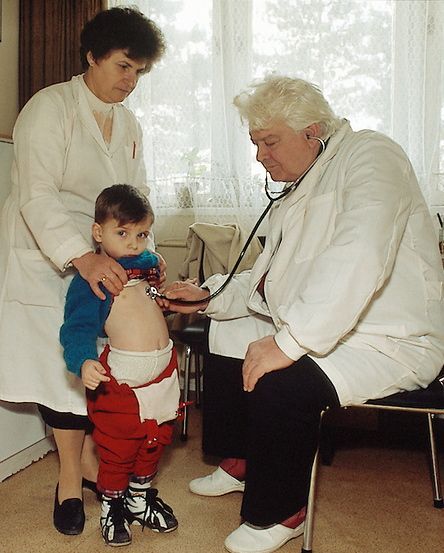Believe it or not, general surgeons and family physicians are the Fat Cats of American medicine, not in terms of income, but in terms of girth—a troubling indicator that the nation’s medical community ain’t exactly health.
According Medscape’s new 2014 Physician Lifestyle Report , 49% of all general surgeons are overweight or obese, with self-reported BMIs greater than 25. Family physicians followed closely, with 48% meeting criteria for overweight/obesity.
48% meeting criteria for overweight/obesity.
The Medscape report summarizes a survey of more than 31,000 US doctors. Overall, 34% of the physicians surveyed said they were overweight; 8% qualified as obese.
Tracking closely with prevalence figures in the general population, overweight among doctors exceeded 30% in 24 of the 25 specialties covered by the survey.
What’s the skinniest specialty? Dermatology! Twenty-three percent of dermatologists are overweight.
Despite the significant prevalence of overweight, the vast majority of American doctors consider themselves healthy. Across all specialties, more than 80% of respondents view their health as “good to excellent.”
A Guy Thing
Prevalence of overweight was higher among male (39%) versus female physicians (26%), a distinct difference from the general US population, in which prevalence shows no gender differences.
However, the male bias is consistent with data showing that while obesity rates are high among both men and women, they have been stable among American women for the last decade, while they are increasing rapidly among men, as Dr. John La Puma recently pointed out at HPC’s 2013 Heal Thy Practice conference.
Overweight among physicians did show interesting correlations with dietary patterns. Among normal/underweight doctors, 62% reported following diets rich in fruits and vegetables such as the Mediterranean or American Heart Association diets. Among overweight, obese doctors, only 39% followed veg-rich regimens. Overweight clinicians were more likely to eat an “on the go” diet heavy on meats, white flour, potatoes, other carbs and processed fats.
It is interesting that less than 5% of all doctors follow the Dean Ornish diet, though it was pioneered by a highly respected physician and is very well supported by scientific research not only for weight loss, but for reversing heart disease and preventing cancer. Under 10% of Medscape respondents are vegetarian/vegan.
The Exercise Cure
Though overweight is all-too-common among US doctors, it is clear that many are actively struggling with it, and are seeking ways to lose weight and reclaim health.
If they’re not doing so well on the dietary front, many are trying to make up for it with the exercise prescription: 72% of normal weight clinicians say they exercise at least twice weekly, as do 57% of those who are overweight and 38% of those who are obese.
Supplement Use Rising
While mainstream medical organizations have generally taken skeptical positions on vitamins and supplements, the Medscape survey suggests that a majority of doctors err on the side of using them: 62% of those over 46 years of age are taking supplements, as are 48% of those 45 and younger. Women are more inclined toward using supplements than men (61% versus 54%).
The most utilized categories of supplements were: multivitamins (33% of men; 37% of women); vitamin D (24% of men, 36% of women); calcium (10% of men, 27% of women), and omega-3s (22% in both genders).
A large number of respondents are also open to using “CAM therapies” for their own health. Thirty eight percent of those over 46, and 37% of those 45 and younger report using at least one form of CAM, and there’s a clear gender distinction with women significantly more open than men (48% versus 32%). Acupuncture, massage and chiropractic/osteopathic manipulation were the most popular modalities.
Give ‘em a Break!
One thing that today’s doctors are not taking much of is downtime: in most of the specialties, less than 20% of physicians take more than 4 weeks of vacation time per year. Family physicians and general internists are among the least rested, with only 13% of these doctors taking 4 weeks off. Anesthesiology and radiology, on the other hand, are the best-rested, with 50% of the doctors in these groups getting at least 4 weeks of R&R.
How happy are American doctors? It varies widely by specialty. Overall, ophthalmologists and dermatologists are the cheeriest both at home and at work. Internists and critical care specialists are down at the bottom on the happiness scale, both at work and in their personal lives.
Family physicians are somewhere in the middle; while they are near the derms in terms of happiness at home, they are more like the internists in work satisfaction (or should we say dis-satisfaction?).
Shifting Political Stances
In addition to tracking health indicators, the Medscape survey also looks at physicians’ political attitudes.
Sixty two percent of female doctors, and 56% of males consider themselves to be “socially liberal.” Fifty eight percent of the females and 70% of the males say they are “fiscal conservatives.” Medscape notes a small but significant downturn in socially liberal leanings, and a marked downturn in fiscal conservatism in both genders over the 2 years since its last survey.
Medscape’s online survey was conducted from October 16 to December 4, 2013, and was fielded from a pool of 413,386 US physicians. The survey was administered by an independent third-party collection company. A total of 31,399 doctors responded, representing 25 different specialties.
A summary report authored by Medscape’s Carol Peckham, as well as specialty-specific breakdowns are available free of charge from Medscape’s website.
END







